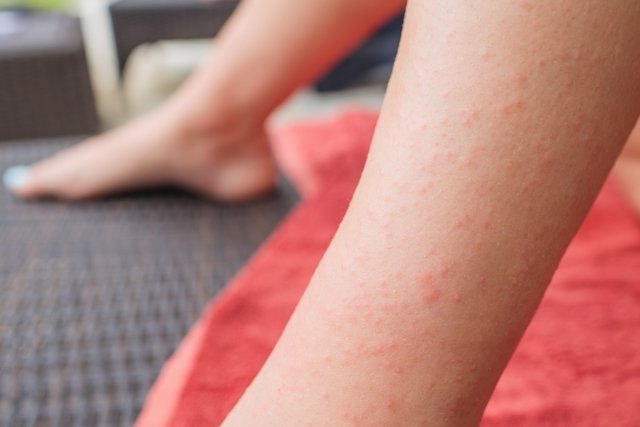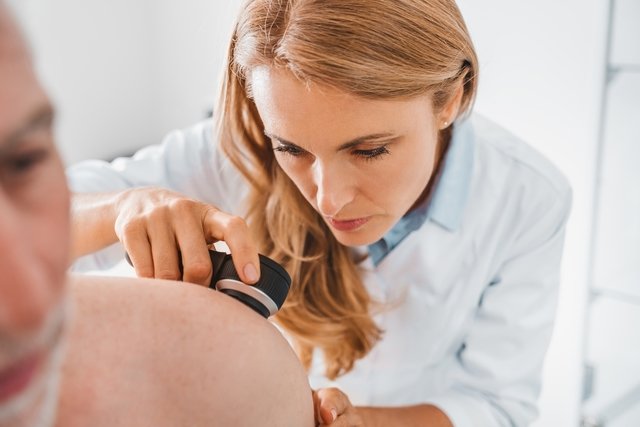Dermatitis herpetiformis is a chronic autoimmune disease that causes symptoms such as small red blisters on the skin, which can be grouped together and cause intense itching, similar to lesions caused by herpes, most frequently affecting the skin of the scalp, shoulders, buttocks, elbows and knees. .
This disease, also known as Duhring-Brocq disease or celiac dermatitis herpetiformis, is more common in people who suffer from celiac disease, as it appears to be related to sensitivity to gluten, which is the protein present in rye, wheat, malt and barley. . Understand what celiac disease is and its main symptoms.
The treatment of dermatitis herpetiformis is carried out by a dermatologist or general practitioner, and involves changes in the diet, eliminating gluten from the daily diet, and the use of antibiotics to help alleviate symptoms.
Sensitive content
This image may contain content that is uncomfortable for some people.

Symptoms of dermatitis herpetiformis
The main symptoms of dermatitis herpetiformis are:
- Red, grouped blisters on the skin;
- Flat red spots;
- Itchy back, scalp, shoulders, buttocks, elbows or knees;
- Burning sensation in the affected regions;
- Blisters that burst easily when scratching;
- Red plaques or welts with scaling;
- Wounds around the blisters.
The symptoms of dermatitis herpetiformis are common to appear on the scalp, buttocks, elbows, knees and back and generally appear symmetrically, that is, it appears on both elbows or both knees, for example.
Generally, dermatitis herpetiformis does not leave scars on the skin after the lesions disappear, however, it may leave light or dark patches on the skin.
Online symptom test
Dermatitis herpetiformis is a type of dermatitis, like contact dermatitis and atopic dermatitis. To find out if you have dermatitis, please select the symptoms you present:
This test is a tool that only serves as a means of guidance and is not intended to provide a diagnosis or replace consultation with a dermatologist or general practitioner.
How to confirm the diagnosis
The diagnosis of dermatitis herpetiformis is made by a dermatologist or general practitioner by evaluating the characteristics of the skin lesions and health history.
If you want to assess your risk of dermatitis herpetiformis, make an appointment with the dermatologist closest to you:
Taking care of your health has never been easier!
To confirm the diagnosis, the doctor must request a skin biopsy, in which a small piece of the lesion is removed to be evaluated in the laboratory, making it possible to evaluate in more detail the characteristics of the lesions and the presence of immunoglobulin A at the site, which which is common to be seen in dermatitis herpetiformis. Find out how a skin biopsy is performed.
In addition, the doctor must order tests to diagnose celiac disease, such as urine, feces and blood tests to check antibody levels, genetic testing and intestinal endoscopy with biopsy, for example.
Possible causes
The main cause of dermatitis herpetiformis is gluten intolerance, as this substance is capable of activating the immune system, leading to the formation of immunoglobulin A (Ig A), a substance that leads the body to attack intestinal and skin cells. .
Genetic predisposition, that is, having first-degree relatives, such as a father or mother with celiac disease or dermatitis herpetiformis, appears to increase the risk of developing these diseases.
Additionally, exposure to iodine also appears to increase the risk of flare-ups of dermatitis herpetiformis in people with celiac disease.
How the treatment is carried out
Treatment for dermatitis herpetiformis should be guided by a dermatologist or general practitioner according to the characteristics of the blisters and other symptoms presented. Therefore, it is initially recommended to eat a gluten-free diet, as this will prevent the appearance of new blisters. See how to eliminate gluten from your diet.
However, as the diet takes some time to take effect, the dermatologist may also recommend the use of an oral antibiotic, such as dapsone, which relieves symptoms in 1 to 3 days. As it can cause several side effects, such as diarrhea, nausea and even anemia, the dose of dapsone must be reduced over time until the minimum dose capable of relieving symptoms is found.
In the case of people who cannot tolerate treatment with dapsone, the dermatologist may prescribe the use of corticosteroid ointments or the use of other antibiotics, such as sulfapyridine, for example.
Bibliography
- GARCÍA, C.; ARAYA, M. Dermatitis herpetiformis and celiac disease. Reef With Chil. 149. 9; 1330-1338, 2021
- BRAZILIAN SOCIETY OF DERMATOLOGY. Dermatitis Herpetiformis (Duhring-Brocq’s Dermatitis). 2021. Available at: <https://www.sbd.org.br/doencas/dermatite-herpetiforme-dermatite-de-duhring-brocq/>. Accessed on January 13, 2023
- MIRZA, H. A.; GHARBI, A.; BHUTTA, B. S. IN: STATPEARLS (INTERNET). TREASURE ISLAND (FL): STATPEARLS PUBLISHING. Dermatitis Herpetiformis. 2022. Available at: <https://www.ncbi.nlm.nih.gov/books/NBK493163/>. Accessed on January 13, 2023
- REUNALA, T.; et al. Dermatitis Herpetiformis: An Update on Diagnosis and Management. Am J Clin Dermatol. 22. 3; 329–338, 2021
- ANTIGA, E.; et al. Dermatitis Herpetiformis: Novel Perspectives. Front Immunol. 10. 1290, 2019
- CELIAC DISEASE FOUNDATION. Dermatitis Herpetiformis. Disponível em: <https://celiac.org/about-celiac-disease/related-conditions/dermatitis-herpetiformis/>. Acesso em 13 jan 2023
- NATIONAL INSTITUTE OF DIABETES AND DIGESTIVE AND KIDNEY DISEASES (NIDDK). Dermatitis Herpetiformis. 2014. Disponível em: <https://www.niddk.nih.gov/health-information/professionals/clinical-tools-patient-management/digestive-diseases/dermatitis-herpetiformis>. Acesso em 13 jan 2023
- MENDES, Fernanda BR; HISSA-ELIAN, Adauct; ABREU, Marilda AMM; GONÇALVES, Virginia S. Review: dermatitis herpetiformis. An Bras Dermatol. Vol 88. 4 ed; 594-599, 2013
- BRAZILIAN SOCIETY OF DERMATOLOGY. Dermatitis Herpetiformis (Duhring-Brocq’s Dermatitis). Available at: <https://www.sbd.org.br/dermatologia/pele/doencas-e-problemas/dermatite-herpetiforme-dermatite-de-duhring-brocq/66/>. Accessed on April 20, 2021

Sign up for our newsletter and stay up to date with exclusive news
that can transform your routine!
Warning: Undefined array key "title" in /home/storelat/public_html/wp-content/plugins/link-whisper-premium/templates/frontend/related-posts.php on line 12
Warning: Undefined array key "title_tag" in /home/storelat/public_html/wp-content/plugins/link-whisper-premium/templates/frontend/related-posts.php on line 13




